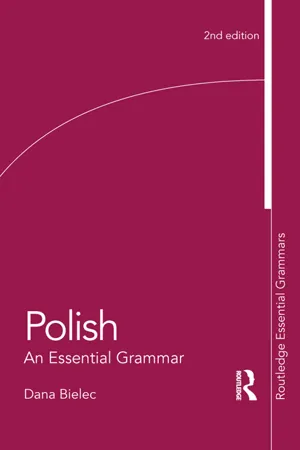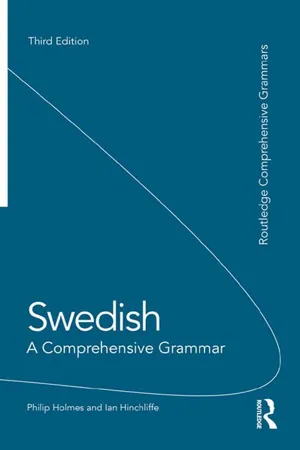Coordinating Conjunctions
Coordinating conjunctions are words that connect two or more elements of equal grammatical rank, such as words, phrases, or clauses. They are used to join independent clauses, coordinate words in a list, or connect phrases. Common coordinating conjunctions include "and," "but," "or," "nor," "for," "so," and "yet." These conjunctions play a crucial role in forming complex and compound sentences.
7 Key excerpts on "Coordinating Conjunctions"
- eBook - ePub
Grammar, Meaning, and Concepts
A Discourse-Based Approach to English Grammar
- Susan Strauss, Parastou Feiz, Xuehua Xiang(Authors)
- 2018(Publication Date)
- Routledge(Publisher)
...14 The Grammar of Connecting, Adding, Conjoining, Contrasting, Indicating Alternatives, and Expressing Stance Conjunctions Figure 14.1 “I clawed my way to the top of the corporate ladder, but I couldn’t get back down and they had to call the Fire Department.” © Randy Glasbergen. Reproduced with permission of Glasbergen Cartoon Service. A conjunction is the part of speech that connects words, phrases, clauses, and sentences. Conjunctions can be categorized as Coordinating Conjunctions (i.e., and, or, but, nor, yet, so, for), correlative conjunctions (either/or, neither/nor, both / and), and subordinating conjunctions (e.g., since, because, before, after, when, if, although, even though, while). Subordinating conjunctions function as adverbials (see Chapters 2 and 15). Logical connectors like however, moreover, and therefore are also conjunctions that function as adverbials. 14.1 Coordinating Conjunctions Coordinating Conjunctions connect two or more words or bits of language that belong to the same category or part of speech (Larsen-Freeman & Celce-Murcia, 2016; Quirk et al, 1985). The well-known mnemonic for the seven Coordinating Conjunctions in English is FANBOYS: And while the mnemonic can be generally helpful, it’s not always accurate for a number of reasons. For example, so, yet, and for do not conjoin the full scope of constituent types, and other words in English in addition to these seven can also function to conjoin words, phrases, and clauses. Of the seven, the most common Coordinating Conjunctions are and, but, and or. Examples: NP and/or/but NP bacon and eggs friends, relatives, or acquaintances a hibiscus with blossoms but no leaves adjective and adjective red, white, and blue snow cones hot or cold appetizers His management style was tough but fair verb phrase and/or/but verb phrase The crew just needed some time to relax and unwind. Taavi could not eat or drink anything after his surgery. How do I save an Instagram photo but not post it? independent...
- eBook - ePub
- Dana Bielec(Author)
- 2012(Publication Date)
- Routledge(Publisher)
...Chapter 11 Conjunctions There are two types of conjunction. 1 Coordinating Conjunctions. These join words, phrases or clauses which have an identical grammatical sense and function in a sentence. They are simple to use and occur frequently, e.g. and, but, or, either … or, neither … nor, both … and. A frequent error is to use Coordinating Conjunctions to join phrases with different grammatical sense or function. Correct Paula likes chips but I prefer potatoes. Jack lives in Bristol and I often visit him there. Incorrect Paula likes chips and my Granny likes cats. Jack has a house but Granny doesn’t like him. 2 Subordinating conjunctions. These introduce noun clauses or adverbial clauses. They can begin a sentence or join clauses. I know that you are tired. [introduces noun clause ‘you are tired’] Jim will ring if he has a problem. [introduces clause of condition] Before I go out, I’ll cut the grass. [introduces clause of time] Some Polish conjunctions have several, sometimes very different, meanings: 11.1 Coordinating Conjunctions Commas are required as follows. 1 Before the second of two identical conjunctions. 2 Before ale and lecz. 3 Before every i in a series, except the first. To avoid repetition, oraz often replaces the last i. 4 Before a if the following clause contrasts with the preceding one (i.e...
- eBook - ePub
A Sentence Diagramming Primer
The Reed & Kellogg System Step-By-Step
- Dr. Judith Coats(Author)
- 2017(Publication Date)
- Page Publishing, Inc.(Publisher)
...Conjunctions: The Three Types Are Coordinating, Subordinating, and Correlative Grammatical explanation. Coordinating Conjunctions join grammatical equivalents (green and white, green or white, green yet white), subordinating conjunctions make one clause dependent on the other (since she wore green, she cheered for the other team), and correlative conjunctions work in pairs but still join grammatical equivalents (not only green but also white, whether green or white, both green and white). Diagramming explanation. Conjunctions will be placed on dotted lines because they are joining words. So the lines on which they are diagrammed are broken because they simply function to join groups of words, phrases, or clauses. So there will be intervening words before and after the conjunctions—thus the broken lines. The following is a sample sentence for correlative conjunctions: Note that we’ll wait just a bit to demonstrate the subordinating conjunction until after we introduce the concept of diagramming multiple clauses in one sentence....
- eBook - ePub
- Jack Umstatter(Author)
- 2010(Publication Date)
- Jossey-Bass(Publisher)
...Similarly, in the sentence, “You can swim or jog during the afternoon class,” the conjunction or joins the two verbs swim and jog. A coordinating conjunction is a single connecting word. The seven Coordinating Conjunctions are for, and, nor, but, or, yet, and so. An easy way to remember these seven conjunctions is the acronym FANBOYS, in which the first letter of each conjunction is used. Activity Underline the coordinating conjunction in each of these sentences. I will not be able to go to the field for I have not completed my science project. Paola would like to be here with us, yet she has to watch over her younger sisters today. This seems like a terrific plan, but I am not sure that the town can afford such a high tab. Perhaps you or your neighbors will be able to organize the block party this year. Do you think that we should put the paint on now so it will have time to dry? 16 the correlative conjunction Just as the coordinating conjunction does, the correlative conjunction joins words or groups of words. Here are the five pairs of correlative conjunctions. Whether... or Neither... nor Both... and Either... or Not only.....
- eBook - ePub
Icelandic
An Essential Grammar
- Daisy L. Neijmann(Author)
- 2021(Publication Date)
- Routledge(Publisher)
...Chapter 13 Conjunctions, interjections and exclamations DOI: 10.4324/9781315731056-13 13.1 Conjunctions: form and function Conjunctions are words that link other words, phrases or clauses together. There are two types of conjunctions: 1) Coordinating Conjunctions join words, phrases or clauses which have an identical grammatical function. They always appear between the words or groups of words that they link. Examples of conjunction (linking) of identical elements: two subjects: the dog and the cat stared at each other two adjectives: she was stern but kind two verbs: will you stay or go? two main clauses: he washes the dishes and she dries them 2) Subordinating conjunctions link subordinate clauses to the main sentence. A subordinate clause forms part of and is dependent on a main (or larger) clause (i.e., is “subordinate”). It is usually a noun clause or an adverbial clause (see 14.2), and is introduced by a subordinating conjunction. It can begin a sentence or join a clause. Examples: I think | that he is right (introduces a noun clause: “he is right”) I will let you know | if he rings (introduces an adverbial clause of condition) While you are away, I will cut the grass (introduces an adverbial clause of time) Conjunctions may consist of one or more words. Commas are not generally used with conjunctions in Icelandic, unlike what happens in English, with only a handful of exceptions (see 13.4.3 below; also 3.10). 13.2 Coordinating Conjunctions The following are generally considered to be the Coordinating Conjunctions in Icelandic: Single: Dual (split): og (“and”) bæði … og (“both … and”) eða (“or”) hvorki … né (“neither … nor”) en (“but”) annaðhvort … eða (“either … or”) heldur (“but, rather, instead”) hvort (heldur) … eða (“whether [rather] … or”) enda (“and indeed, what’s more, since, on the condition that”) ýmist … eða (“sometimes … sometimes; ellegar (“or, otherwise”) either …...
- eBook - ePub
- Philip Holmes, Ian Hinchliffe(Authors)
- 2013(Publication Date)
- Routledge(Publisher)
...Chapter 8 Conjunctions 8.1 Coordination and subordination Conjunctions are elements that are outside the actual clause and have a linking function. For main clauses (MC) and subordinate clauses (SC), see 10.3.1 ff., 10.4.1 ff.; for link position, see 10.6.10 ; for the form, function and position of subordinate clauses, see 10.7.1 – 10.7.7. 8.1.1 Coordination Coordination involves the linking together of two clauses or elements of a similar kind. The link used is often a coordinating conjunction placed between the elements to be linked. See 8.2.1 ff. Subjects coordinated Alice och Albin gillar opera. Alice and Albin like opera. Verbs coordinated De sitter och lyssnar. They are sitting and listening. Main clauses coordinated Jag hjälper dig och du hjälper mig. I help you and you help me. Subordinate clauses coordinated De sa att de var trötta och att det var dags att åka hem. They said that they were tired and that it was time to go home. 8.1.2 Subordination Subordination involves the incorporation of a subordinate clause (indicated by brackets in the examples below) into a main clause sentence (indicated by < >). The link word used is often a subordinating conjunction (8.3.1 ff.) or other subordinator (8.4.1 ff.) placed at the beginning of the subordinate clause. In the example below, the subordinating conjunction is därför att. The subordinate clause in the example is subordinated to (i.e. dependent on) the main clause and forms part of the larger main clause sentence. See 10.7.5. <Jag hjälper dig (därför att du hjälper mig)>. I help you because you help me. Main clause – Independent Subordinate clause – Dependent There is often a hierarchy of clauses, one within another, by which clauses are subordinated. In the example below, the subordinate clause marked [C-C] is subordinated to the subordinate clause (B-B), which in turn is subordinated to the main clause sentence <A-A>...
- eBook - ePub
- Julian Granberry(Author)
- 2012(Publication Date)
- Dover Publications(Publisher)
...CONJUNCTIONS Swedish, like English, has two major kinds of conjunction: Coordinating Conjunctions and subordinating conjunctions. Coordinating Conjunctions Coordinating Conjunctions (e.g., “and,” “or” and “but” in English) usually link together two or more independent clauses. The principal conjunctions of this type in Swedish are presented here along with examples of their usage: och and Jag gick hem och skrev ett brev. I went home and wrote a letter. bade... och both... and Jag dricker både te och kaffe. I drink both tea and coffee. eller or Vill ni ha mjölk eller vatten? Would you like milk or water? antingen... eller either... or Jag går antingen till Stockholm eller till Malmö nästa sommar. I shall be going either to Stockholm or to Malmö next summer. varken... eller neither... nor Nar han kom, var han varken trött eller kall. When he arrived, he was neither tired nor cold. men but Han hade gärna velat komma, men han var sjuk. He would have liked to come, but he was sick. Subordinating Conjunctions Subordinating conjunctions introduce dependent clauses (e.g., “that,” “because” and “if” in English)...






